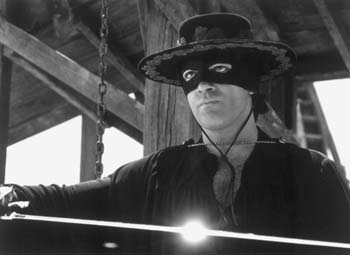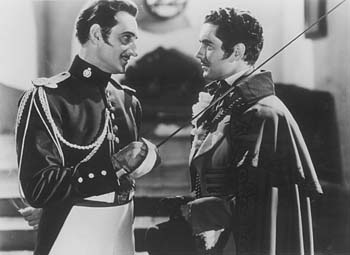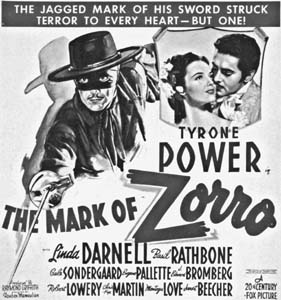Mister Fox Trots
Oh, Say Can You 'Z': Antonio Banderas does his part to terrorize greedy landlords and to promote the last letter of the alphabet in 'The Mask of Zorro.'
Antonio Banderas' Zorro is the latest in a long line of masked cinematic vigilantes fighting for justice in old California
OUT OF THE DULLNESS of Southern California history, all dust and oxen and bald men in brown robes, a pulp writer named Johnston McCulley wrote his own footnote in history by creating Señor Zorro (Mr. Fox). Zorro made his debut in a 1919 serial for the magazine All-Story Weekly. "The Curse of Capistrano," reprinted a few years later in book form, was the first of 40 years worth of Johnston's stories about the masked avenger of colonial California.
McCulley, a newspaper reporter, wasn't a writer who loved chartreuse prose. He told his story urgently, even at the cost of tipping off the reader too early that Don Diego de la Vega, 1820s lounger, was indeed too spineless to be real. The pitiable fop Don Diego is "noted the length of the El Camino Real for his small interest in the really important things of life."
One of these important things is his fiancée, Senorita Lolita, too hot-blooded to be wedded to a man more interested in silks and velours than in women's flesh. She is understandably "thrilled to the tips of her tiny toes" by the masked stranger Zorro. Zorro flirts with her, but he's really engaged in his work: cleaning up a California then, as now, plagued by avaricious landlords and misrule. If only he'd come back and carve a "Z" in Pete Wilson's chest.
McCulley's basic idea came from The Scarlet Pimpernel, by the Baroness Orczy, née Mrs. Montague Barstow. (Incidentally, a scarlet pimpernel is a small strangler vine with pea-sized flowers, a nuisance in California gardens.) Orczy's character is an early example of a multimedia franchise: first a celebrated play; then a novelization (1903); later, six different films and a TV show.
The damned elusive Pimpernel's task was saving the aristocracy. Zorro, by contrast, is a left-wing hero. He's out for social justice, beating those who beat the peasants. (The title scroll from the 1936 Zorro movie, The Bold Caballero, put it this way: "The tortured Indians, taxed into slavery, prayed for a deliverer.") Zorro aids the Franciscans, who are the liberation theologians of their time. Satire does the critic's job of pointing out Zorro's tendencies. In the affectionate 1981 parody film about the "swishbuckler" Zorro, the Gay Blade, the romantic lead, Charlotte Wilson (Lauren Hutton), is a Boston revolutionary representing the People's Independence Committee.
THE FIRST Zorro film came hard on the flashing heels of McCulley's serial; Douglas Fairbanks Sr. bought the rights and in 1920 made the energetic and funny Mark of Zorro (which he sequelized five years later as Don Q, Son of Zorro). The most mature version of some 35 Zorro films was Rouben Mamoulian's 1940 remake, The Mark of Zorro (which shows July 23-24 at the Stanford Theater in Palo Alto).
Mamoulian's version, which starred Tyrone Power, is a movie about black and white contrasts: white-hot, sun-struck villages and the black rider who awakens them; Zorro's black mask and the white highlights of his eyes. The film, made under the looming clouds of war, expressed fury at tyranny and championed the guile and the vigor to fight it. Indeed, it stars one of cinema's finest crypto-fascist villains, Basil Rathbone's Captain Pasquale, on point throughout the picture.
Pasquale has an ugly habit of swishing his sword blade in conversation, preparing himself and the audience for the short, intense close-quarters duel in the finale. As Tom Milne notes in his book on Mamoulian, this swashbuckler escapes the genre it masters. The romance with Linda Darnell--amid some distractions by the kinky Gale Sondergaard--is almost more important than the sword fighting itself.
In the newest Zorro movie, The Mask of Zorro, which opened last week, an elderly Don Diego (Anthony Hopkins) is driven from home and family. To avenge himself, he literally passes on the mantle of Zorro to Alejandro Murieta (Antonio Banderas), brother of the famous outlaw of early-California history, Joaquin. In the splendid opening sequence, Hopkins' Zorro confronts the retiring Gov. Don Rafael Montero (Stuart Wilson), whips up the mob and tears the Spanish flag from its pole. As did Fairbanks' 1920 version, The Mask of Zorro celebrates how lightly great power can rest on a man's shoulders.
Sadly, this opening leads to slower work, especially the scenes of the elder Zorro's training of the young, impetuous Alejandro. The passages are modeled to the point of plagiarism on Obi-Wan Kenobi's taming of the young Luke Skywalker. And Hopkins is such a dreary actor when he mopes; his Celtic gloom seems out of place. The scenes of Banderas doing pushups over lighted candles is a steal from Jackie Chan's training ordeals in the Drunken Master movies--a very bad steal, too. Effortlessness ought not to be seen as a result of effort. Who really wants to watch Zorro's workout tape?
The explosions and the Dolbyized thunking of flesh in the fist fights represent a sad condescension to 12-year-olds. The worst of the film is the punched-up violence, a sign that too much work was done to make The Mask of Zorro "not your parents' Zorro."
Still, much more of the new Zorro delights than fails. The thrilling opening hooks younger kids to a story that once pleased their elders. James Horner's flamenco-influenced soundtrack is rousing without being bombastic. The production design is a glorious vision of colonial California in Maxfield Parrish colors.
Director Martin Campbell, who rehabilitated James Bond in GoldenEye, must have conceived the idea to filch the traditional 007 opening. Enter Zorro, spurs jingling. He draws his sword at the audience, just as Bond crouches and shoots at the audience before the titles of his films.
Banderas is the first Spanish-accented Zorro--in a U.S. film, at least. (For every one Zorro movie made here, there have been three made in Latin America, Italy, Spain and Mexico.) A Chicano audience that reveres the legendary Murieta may find pleasure in the new film's linking of a real-life hero with the fictional Zorro. Banderas also has a strong understanding of the comic, paranoid side of machismo, developed from his years with the Spanish satirist Pedro Almodovar.
The Mask of Zorro bears some passing resemblance to The Bold Caballero (recently available on Republic Pictures Home Video). Set (nominally) in Santa Cruz, the adventurous B-film stars the amiable third-string cowpoke hero Bob Livingston as Zorro. (Livingston, notes Western film historian Ernest Corneau, played more masked cowboy heroes than any other actor in history. Livingston was not only Zorro and the Lone Ranger but also lesser known cliffhanger heroes like the Eagle.)
One device from The Bold Caballero--the Zorro signal of a blazing "Z" burnt into the hillside--turns up in The Mask of Zorro. So does the motif of a don's daughter as both love interest and adversary. The Bold Caballero was the first color Zorro picture and also Republic's first color film. The action scenes in this turquoise-and-orange-tinted tale are quickly paced; The Bold Caballero is a fine example of the technical intelligence and remarkable horsemanship of that great factory for the making of Westerns.
THE STORY of Zorro actually goes back beyond eight decades. The tale of a dispossessed prince returning in disguise can be traced all the way to The Odyssey, in which Ulysses returns to his court under an assumed name. Similar stories come down to us through the years, from fairy tales to folk ballads like "John Riley."
The thread continues to Zorro's direct progeny, Batman, another caped, masked prince. (The Mask of Zorro gives our hero a "Lair of the Fox" that looks like a batcave.) But Zorro, like Batman, has the nasty undertone that accompanies all vigilantes, even left-wing ones. In the original Zorro stories, a masked man rouses the local noblemen to action with talk of their good blood and breeding--as opposed, say, to those, less eugenically favored?
Johnston McCulley's first Zorro adventures were written in 1919, during one of the peak eras of racial violence in the U.S., and the first appearance of Zorro is contemporaneous with the rise of a whole order of masked, whip-wielding vigilantes: the Ku Klux Klan.
Decades of filmmaking have leached out the aristocracy and filtered in more populism. Livingston's Zorro describes himself as "a gentleman pauper." Banderas' Zorro is a career bandit. Although Zorro is the least complex of the Western heroes, he fulfills the essence of all of them, as described by the critic Robert Warshow, who wrote, "[The Westerner] is on the side of justice and order, and of course it can be said that he fights for such things. ... What he defends, at bottom, is the purity of his own image--his honor. ... He is there to remind us of the possibility of style in an age which has put upon itself the burden of pretending that style has no meaning."
The style of Zorro is a man out for a good time. His smile is as much a part of his personality as his mask. Movie heroes with their dark sides have become terrible pulp clichés lately. And Zorro wears his shadow on the outside. In devilish livery, Zorro has an angel's élan.
The Mark of Zorro (1940; unrated; 93 min.), directed by Rouben Mamoulian and starring Tyrone Power, plays July 23-24 with If I Were King at the Stanford Theater in Palo Alto.
[ San Jose | Metroactive Central | Archives ]
![]()

Rico Torres
Letter Perfect: Tyrone Power (right), as the masked one, goes visage to visage with villain Basil Rathbone in the 1940 'Mark of Zorro.' 
Zorro at War: Rouben Mamoulian's 'The Mark of Zorro' was
made as America prepared to enter WWII.
The Mask of Zorro (PG-13; 136 min.), directed by Martin Campbell, written by John Eskow, Ted Elliott and Terry Rossio, photographed by Phil Meheux and starring Antonio Banderas, Anthony Hopkins and Stuart Wilson, plays at selected theaters valleywide.
From the July 23-29, 1998 issue of Metro.
![[Metroactive Movies]](/movies/gifs/movies468.gif)